German 37-55-mm naval anti-aircraft guns during the Second World War
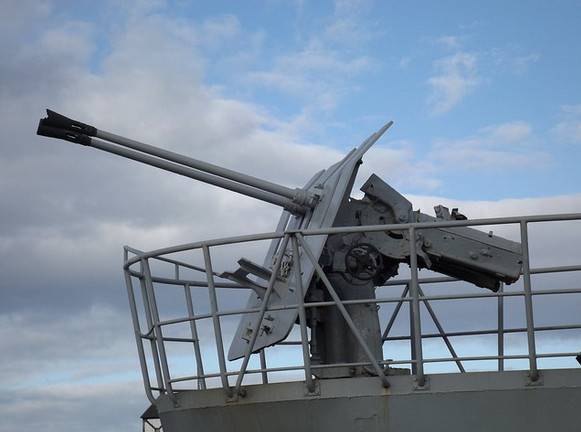
In the initial period of World War II, the anti-aircraft units of the Wehrmacht and the Luftwaffe were armed with anti-aircraft guns, which, in terms of their characteristics, corresponded to or even exceeded artillery systems of a similar purpose in the armies of other states.
However with naval anti-aircraft artillery, things were not so good. If the near air defense zone in the kriegsmarine was provided by the very successful 20 mm 2 cm FlaK C / 30 and 2 cm FlaK C / 38 automatic anti-aircraft guns of a larger caliber on the decks of German ships by the time active hostilities began at sea, there were no.
Hopes for anti-aircraft installations Einh.LC/34, Ubts.LC/39 and Dopp.LC/30, which used 37-mm semi-automatic 3,7 cm SK C/30, were not fully justified. The 3,7 cm SK C/30 semi-automatic universal gun had the best point-blank range and very high accuracy in its caliber. But even a twin installation gave a practical rate of fire of about 60 rds / min, which, moreover, very much depended on the level of training of the loaders. In addition, manual sending of one cartridge compared to automatic installations of the same caliber required a larger number of people involved in the process of loading and carrying ammunition.
As a result, despite all the advantages (including high reliability), the production of 37-mm semi-automatic 3,7 cm SK C / 30 was stopped in 1942, and their place was taken by 37-mm and 40-mm anti-aircraft guns adapted for naval conditions. machine guns previously used on land.
37 mm automatic anti-aircraft guns
While the semi-automatic 37 cm SK C / 3,7 reigned supreme in the Kriegsmarine in caliber 30 mm, the anti-aircraft units of the Wehrmacht and the Luftwaffe actively used 37-mm anti-aircraft guns chambered for 37x263 mm. Let not so powerful and accurate, but much faster.
In 1935, the production of a 37-mm automatic anti-aircraft gun 3,7 cm Flak 18 (Flugabwehrkanone 18), created by the Rheinmetall Borsig AG concern, based on the developments of the Swiss company Solothurn Waffenfabrik AG, began.

37 mm 3,7 cm Flak 18 automatic anti-aircraft gun in firing position
The designers paid great attention to the ease of maintenance and maintainability of the anti-aircraft gun. In particular, threadless connections were widely used in it. Automation worked due to the recoil energy with a short barrel stroke. Shooting was carried out from a pedestal carriage, which was supported by a cruciform base on the ground. In the stowed position, the gun was transported on a four-wheeled cart. The mass of the gun in the combat position is 1 kg, in the stowed position - 760 kg. Calculation - 3 people. Elevation angles: -560° to +7°. In the horizontal plane there was the possibility of circular fire. Guidance drives are two-speed. The maximum firing range for air targets is 7 m.
Power was supplied from 6-round clips on the left side of the receiver. Rate of fire - up to 150 rds / min.
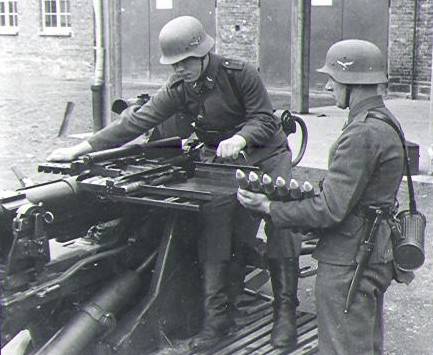
The ammunition included shots: with fragmentation-tracer, fragmentation-incendiary and fragmentation-incendiary-tracer grenades, an armor-piercing high-explosive projectile, as well as a sub-caliber armor-piercing tracer projectile with a carbide core. An armor-piercing tracer with a mass of 680 g was accelerated in a barrel 2 mm long to 106 m/s. At a range of 800 m, when meeting at an angle of 800 °, such a projectile could penetrate 60 mm armor of medium hardness.
In general, the 37-mm 3,7 cm Flak 18 anti-aircraft gun was fully operational and quite effective against aircraft at ranges up to 2 m, and could successfully operate on lightly armored ground and sea targets and manpower within line of sight. However, the troops had complaints about the excessive mass in the transport position, which was caused by a heavy and uncomfortable four-wheeled cart. In addition, the gun was very complex and expensive to manufacture.
In 1936, using a 3,7 cm Flak 18 artillery unit and a new carriage with a two-wheeled wagon, the 3,7 cm Flak 36 anti-aircraft gun was created. A hydraulic recoil brake and a skid were introduced into the design of the artillery unit, along which the machine rolled back.
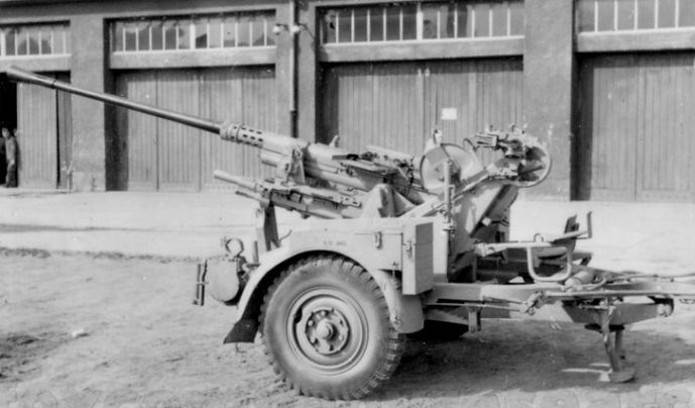
3,7 cm Flak 36 in the stowed position
The mass of the system in the combat position was reduced to 1 kg, and in the stowed position - up to 550 kg. While maintaining the ballistic characteristics and rate of fire of the previous modification in the range from -2 ° to + 400 °, the vertical aiming angles were increased. The ballistic characteristics and rate of fire of the gun remained at the same level.
In 1937, the production of 3,7 cm Flak 37 anti-aircraft guns began. This model outwardly differed from the previous modification in the barrel casing, which is due to the simplification of production technology. The main difference was the introduction of the new Sonderhänger 52 sight with a calculating device. The fire control of the anti-aircraft battery was carried out using the Flakvisier 40 range finder. Thanks to this, it was possible to significantly increase the efficiency of firing at distances close to the limit.
In general, the 37-mm machine guns in service met the requirements. However, when firing at fast-moving air targets, it was highly desirable to increase the combat rate of fire. In this regard, the Rheinmetall Borsig AG concern in 1943 created a new 37 mm 3,7 cm Flak 43 towed anti-aircraft gun.
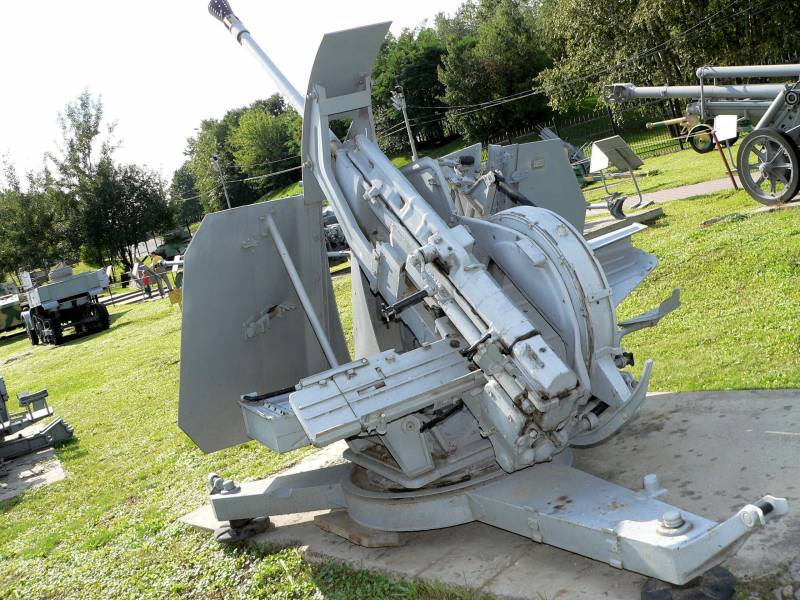
37-mm anti-aircraft gun 3,7 cm Flak 43 in the museum exposition
The elevation angle of the barrel was brought up to 90°, and the principle of operation of the automatics of the artillery unit underwent a significant revision. The short stroke of the barrel during recoil was combined with a gas vent mechanism that unlocked the bolt. Thanks to this, it was possible to combine several operations and reduce the time required to complete all actions when firing a shot. Simultaneously with the increase in the rate of fire to 250 rounds per minute, due to the introduction of an effective spring-hydraulic damper, it was possible to reduce recoil and shock loads on the gun frame.
The barrel length, ammunition and ballistics of the Flak 43 remained unchanged compared to the Flak 36. To increase the effectiveness of anti-aircraft fire, the aiming from a single anti-aircraft fire control device was adopted as the main one. At the same time, individual sights were retained for use outside the 3,7 cm Flak 43 anti-aircraft battery.
To increase the practical rate of fire and the length of the continuous burst, the number of shots in the clip was increased to 8 units. Simultaneously with the increase in combat rate of fire, it was possible to reduce weight. The mass of the gun in the combat position was 1 kg, in the transport position - about 300 kg. The gun was transported on a single-axle sprung trailer, with pneumatic and hand brakes, as well as a winch for lowering and raising the gun when moving it from traveling to combat and back.
The beds had jacks for leveling the anti-aircraft gun. The lifting mechanism is sectoral, with one pickup speed. The rotary mechanism had two aiming speeds. The swinging part was balanced by a balancing mechanism with a spiral spring. Taking into account the experience of combat operations, the 37-mm Flak 43 anti-aircraft gun was equipped with a steel shield with two folding side doors, which reduced the vulnerability of the crew to repel air attacks and shelling from the ground.
The twin 37-mm anti-aircraft gun received the designation Flakzwilling 43. Artillery machine guns were located one above the other, and the cradles on which the machine guns were installed were connected to each other by a rod forming a parallelogram joint. Each automaton was located in its own cradle and formed a swinging part, rotating relative to its annular pins.
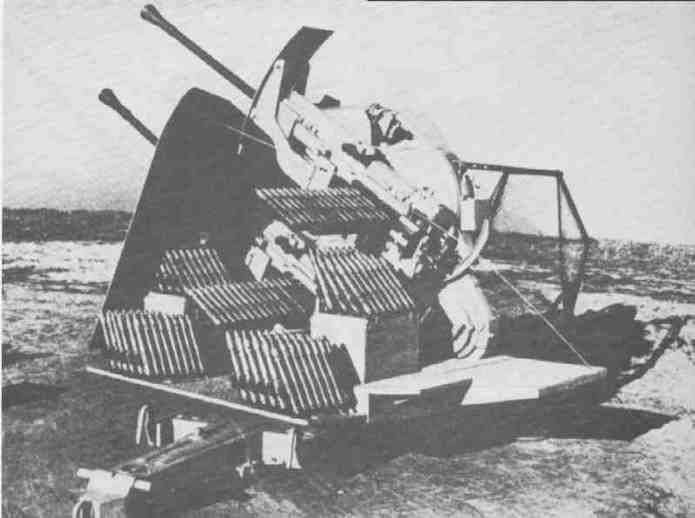
37 mm Flakzwilling 43 twin anti-aircraft gun
Due to the presence of individual trunnions for each machine gun, the effect of recoil on the swinging part of the anti-aircraft gun was minimized. It was also possible to use machines from single installations without any alterations.
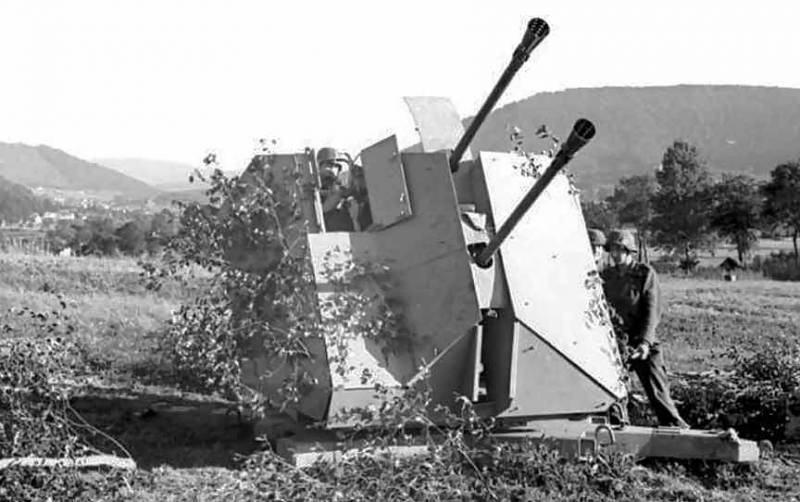
Twin Flakzwilling 37 43 anti-aircraft gun in firing position
The mass of the Flakzwilling 43 compared to the Flak 43 has increased by about 40%, and the combat rate of fire has almost doubled.
In the Wehrmacht, 37-mm towed anti-aircraft guns were reduced to batteries of 6-9 guns. In the anti-aircraft battery of the Luftwaffe, placed in stationary positions, there could be up to 12 of these guns.
After the German facilities began to be raided by the British aviation, the command of the kriegsmarine requested the strengthening of the air defense of naval bases and large-caliber artillery batteries located on the coast. In 1940, several dozen 37-mm anti-aircraft guns, originally intended for the ground forces, were transferred to the fleet. These guns were mainly placed on stationary, well-equipped in terms of engineering positions and railway platforms, which made it possible to quickly strengthen the protection of large naval bases, to which railway lines were connected. During the war, coastal anti-aircraft units of the Kriegsmarine, albeit in smaller numbers than the Wehrmacht and Luftwaffe, continued to receive 37-mm rapid-fire anti-aircraft guns on land carriages.
After getting acquainted with the 37-mm automatic anti-aircraft guns and assessing their combat capabilities, the German admirals came to the conclusion that it was necessary to take them into service with the fleet.
In 1942, using the 3.7 cm Flak 36 artillery unit, the 3.7 cm Flak M42 anti-aircraft gun was created. In September 1943, the new assault rifle was adopted by the Kriegsmarine under the designation 3.7-cm Flak M42 (the designation 3.7-cm M/42 is also found), but deliveries began at the end of 1943. An assault rifle with parts made of corrosion-resistant steels, and intended mainly for placement on submarines, received the designation 3.7 cm Flak M42U. First of all, new single-barreled and twin 37-mm machine guns received type VII-C submarines. At the beginning of 1944, the M/42 guns began to be delivered to surface ships.
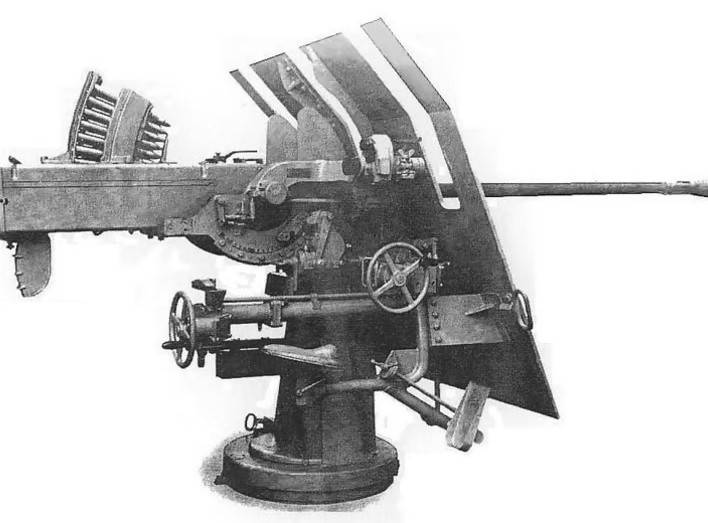
37-mm naval anti-aircraft gun 3.7 cm Flak M42
Taking into account the specifics of the sea, the 37-mm artillery part of the installation was placed on a pedestal, providing a circular fire. Unit weight depending on version 1 320–1 370 kg. Elevation range: -10° to +90°. Compared to the land modification, the barrel length increased from 57 to 69 calibers (from 2 mm to 112 mm) and the thread pitch changed. The rate of fire reached 2 rds / min, the practical rate of fire was half that.
Unlike land-based 37-mm anti-aircraft guns, which had side-loading, naval guns were loaded with clips from above. Calculation of the installation: 4-6 people. Other crew members were brought in to carry ammunition. Partial protection of the calculation from bullets and fragments in the frontal projection was provided by an 8-mm steel shield.
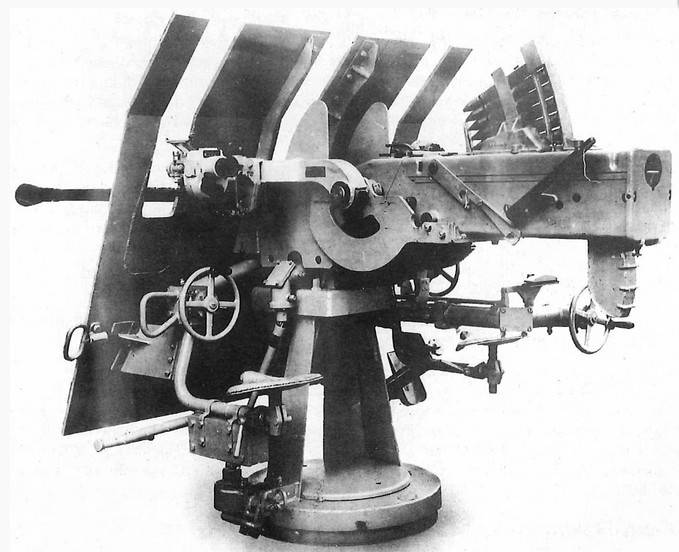
Shields on submarine mounts were hinged so they could be folded back relative to the barrels to reduce water drag.
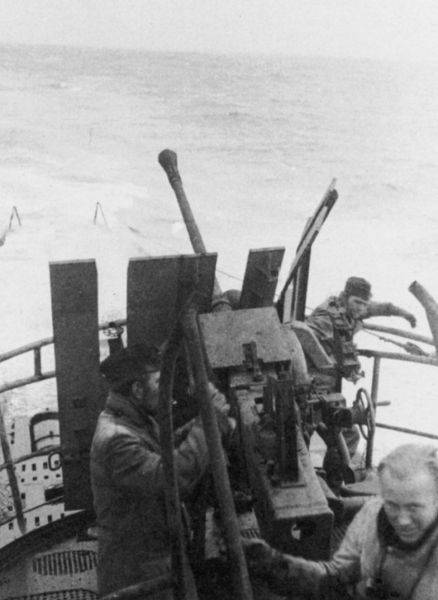
The shields of the installations of surface ships had a more complex shape and did not fold. In addition, the sights of installations on submarines had a sealed design.
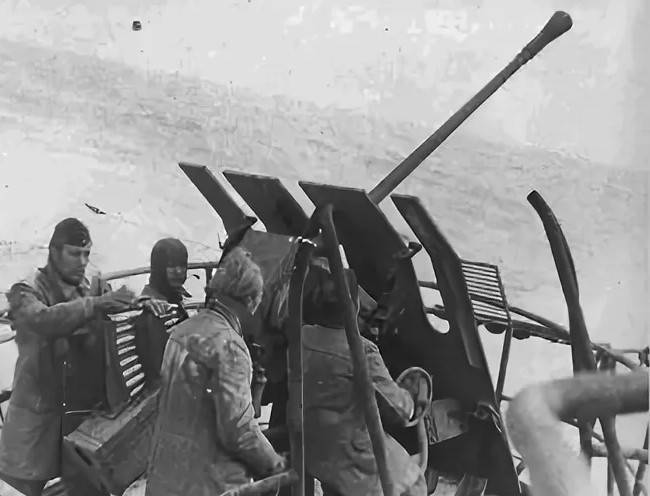
The 3.7 cm Flak M42 naval assault rifle used a 37×248R round. Probably, the rejection of the 7 × 263B "land" ammunition used in the 3.7 cm Flak 36 anti-aircraft gun was associated with a desire to reduce recoil, improve shooting accuracy and reliability. There were three types of shells in the ammunition load: armor-piercing tracer, fragmentation tracer, fragmentation incendiary tracer.

37mm cartridge 37×248R with fragmentation tracer
A fragmentation tracer projectile weighing 0,635 g had an initial velocity of 845 m/s and contained 26 g of TNT. At the end of the war, shells of this type, in order to increase the high-explosive and incendiary effect, began to be equipped with an alloy of TNT and RDX containing about 15% aluminum powder. The reach in height at an elevation angle of 85 ° was 4 m. The effective range of firing at air targets was about 400 m.
The first pedestal mount with a 37mm M/42 assault rifle was the C/36. Probably, index С/36 indicates the use of parts of another installation, model 1936, in the design of the installation. This first option was used for training calculations and various tests; no installation was received on ships and submarines.
The first serial installation with a 3.7 cm Flak M42 was a single-barreled Ubts. LC / 39, designed for submarines, the creation of which used the pedestal base of a single-barreled 37-mm semi-automatic SK C / 30.
Following the installation of Ubts. LC / 39 was followed by a single-barreled Flak LM / 42 for placement on surface ships.
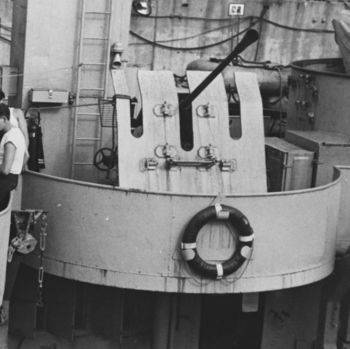
Flak LM/42 single-barrel mount on destroyer Z-39
To increase firepower, twin installations were created. Ubts model. Dop. LM / 42 was intended for submarines, and Dop. LM / 42 - for surface ships.
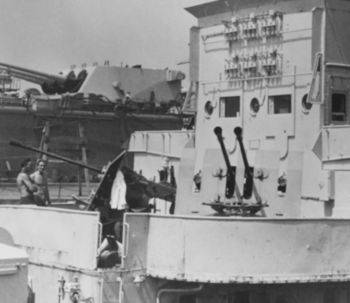
Twin installations Dop. LM/42 on the bow superstructure of destroyer Z-39
As part of the Barbara program, designed to strengthen the air defense of the German fleet with single-barreled and twin M / 42 assault rifles, it was envisaged to replace most of the 37-mm semi-automatic guns.
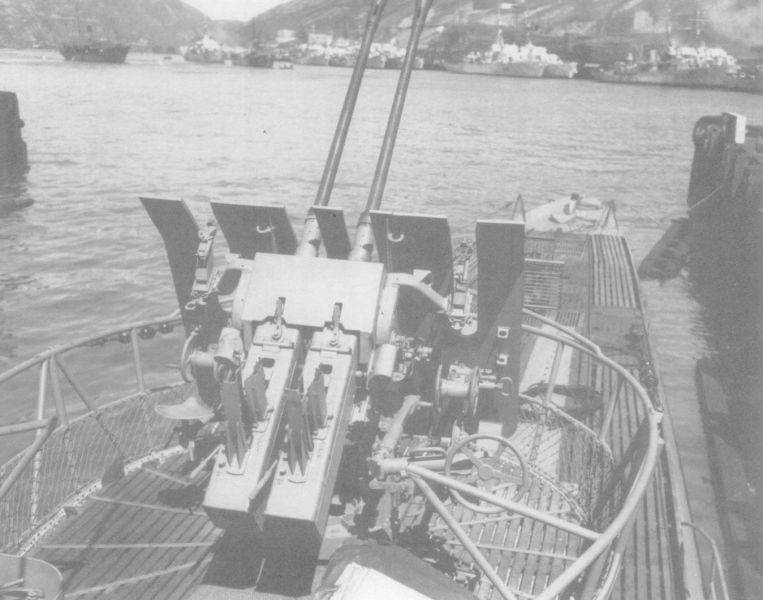
Twin installation Ubts. Dop. LM/42 on a submarine
In particular, it was supposed to place at least fourteen 37-mm machine guns on destroyers, up to 6 barrels on destroyers, 1-2 installations on minesweepers, and 37-mm single-barreled or twin guns on submarines were supposed to replace semi-automatic guns of the same caliber.
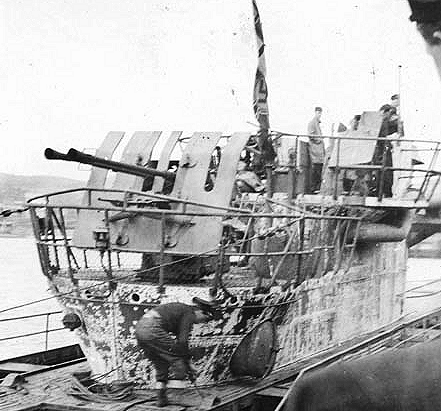
Barbara's program to rearm surface ships was fully implemented on only a few destroyers and destroyers, and what was currently available was installed on many ships. However, some submarines received 37-mm automatic guns in excess of what was originally envisaged by the project.
After Italy withdrew from the war in September 1944, about two hundred 37 mm 37 mm/54 Breda Mod. 1932/1938/1939, designated 3,7 cm Flak Breda(i) by the Germans. In addition to towed anti-aircraft guns on two-axle and four-axle wagons, in good condition it was possible to capture about three dozen single-barreled and twin marine installations, which were subsequently used by the Kriegsmarine on transport-passenger and auxiliary ships, as well as in coastal batteries.
The 37-mm anti-aircraft gun was created by order of the Italian Navy by Breda by scaling the 13,2-mm Hotchkiss M1930 machine gun and was intended to replace the outdated British 40-mm QF 2 pounder Mark II naval anti-aircraft gun.
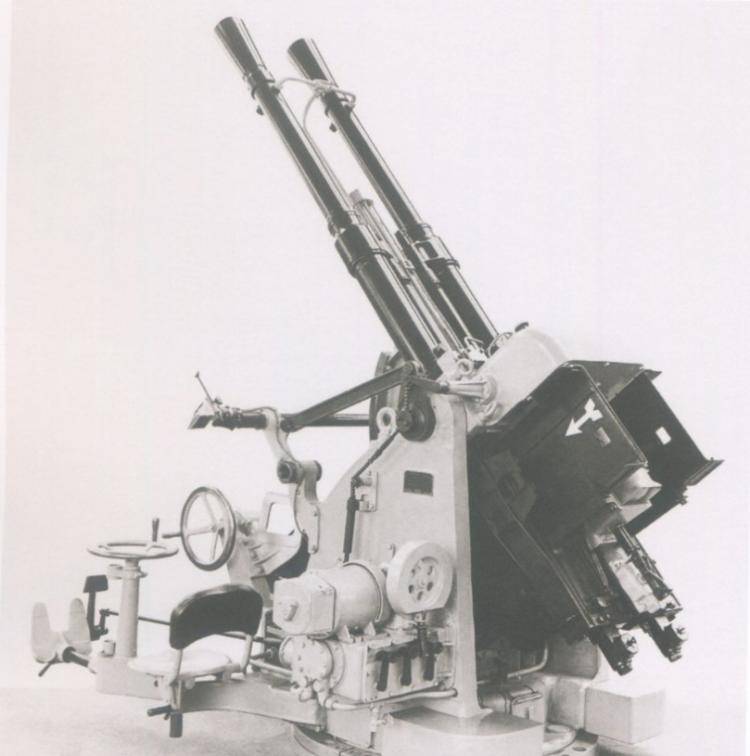
Twin 37-mm anti-aircraft installation 37 mm / 54 Breda mod. Xnumx
The 37x232 SR ammunition was adopted for the new naval rapid-fire gun. Loading was carried out from box magazines for six shots. The total rate of fire of two machine guns reached 240 rds / min. Combat rate of fire - about 100 rds / min. A high-explosive fragmentation projectile weighing 820 g left the barrel with an initial velocity of about 800 m/s. The firing range for air targets is up to 4 m. The Breda 000/37 mod 54 twin marine installation on a stationary pedestal weighed about 1932 tons.
In 1939, a lightweight single-barrel mount 37 mm/54 Breda mod. 1939. The gun was mounted on a tube carriage, designed to be placed on the deck of a ship or in stationary positions. The mass of a single-barrel pedestal installation is about 1 kg.
40 mm automatic anti-aircraft gun 4,0 cm Flak 28
Talking about the small-caliber anti-aircraft guns used by the Nazi German Navy, it is impossible to pass by the 40-mm Bofors L60 machine gun. A number of sources claim that the design of this anti-aircraft gun began during the First World War.
In 1918, the specialists of the Friedrich Krupp AG concern worked on a prototype of a rapid-fire cannon with automatics based on the use of short recoil barrel recoil. In connection with the restrictions imposed by the Treaty of Versailles on Germany, the existing developments on the anti-aircraft gun were allegedly transferred to the Swedish company AB Bofors, which, in turn, brought the gun to the required level of reliability and offered it to potential buyers in 1932.
For the anti-aircraft gun created in Sweden, a 40x311R shot with various types of projectiles was adopted. The main fragmentation tracer was considered to be a 900-g projectile, equipped with 60 g of TNT, leaving the barrel at a speed of 850 m / s. A solid armor-piercing tracer 40-mm projectile weighing 890 g, with an initial speed of 870 m / s, could penetrate 500-mm armor at a distance of 50 m.
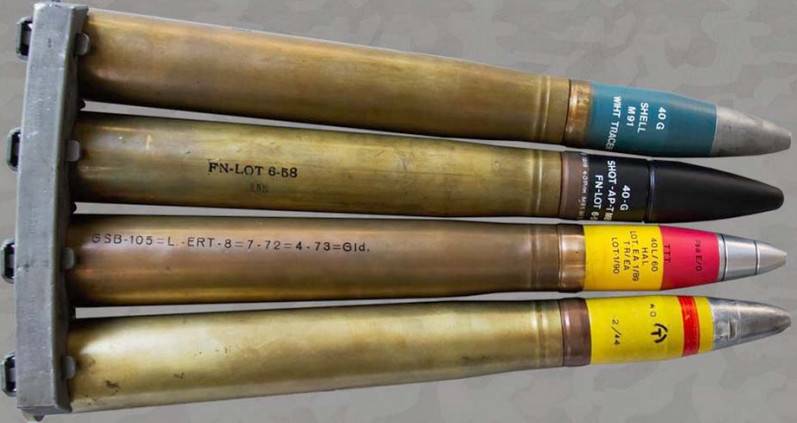
Clip for 40-mm anti-aircraft gun Bofors L60 with different types of shots
In terms of effective shot range and projectile mass, the Bofors L60 anti-aircraft gun was slightly superior to the German 3,7 cm Flak 36, had approximately the same combat rate of fire, but was heavier.
The first customer of the L60 anti-aircraft guns in 1932 was the Dutch Navy, which installed 5 twin 40-mm mounts on the light cruiser De Ruyter. Anti-aircraft guns were mounted on a stabilized mount developed by the Dutch company Hazemeyer.
In the second half of the 1930s, Bofors towed and naval 40-mm anti-aircraft guns were popular with foreign customers. In Europe, before the start of World War II, they were purchased or licensed for mass production: Austria, Belgium, Great Britain, Hungary, Greece, Denmark, Italy, the Netherlands, Norway, Poland, Finland, France and Yugoslavia.
The Wehrmacht became the owner of the 40-mm Bofors in 1938, when, as a result of the Anschluss, the Austrian army got 60 anti-aircraft guns. In Germany, these anti-aircraft guns were designated as 4,0 cm Flak 28. After the occupation of Belgium, Holland, Greece, Denmark, Norway, Poland, France and Yugoslavia, about 400 Bofors L60 anti-aircraft guns were at the disposal of the German army.
Moreover, after the German occupation, mass production of 40-mm anti-aircraft guns was continued at the enterprises: Österreichinschen Staatsfabrik - in Austria, Hazemeyer BV - in the Netherlands, Waffenfabrik Kongsberg - in Norway. The Hungarian metallurgical and engineering consortium MÁVAG delivered about 1944 1-mm Bofors until December 300. The peak of Bofors production at German-controlled enterprises fell on March-April 40, when up to 1944 anti-aircraft guns per month were handed over to the customer.
Although the 40mm caliber was not standard for the German Navy, in July 1941 the Kriegsmarine had 247 4,0 cm Flak 28s. At the same time, the Luftwaffe anti-aircraft units had 615 40mm machine guns.
Initially, German admirals considered 40-mm anti-aircraft guns as a means of strengthening the air defense of coastal facilities, but later, due to the insufficient effectiveness of 20-mm machine guns and 37-mm semi-automatic guns, they began to be put on ships and boats.
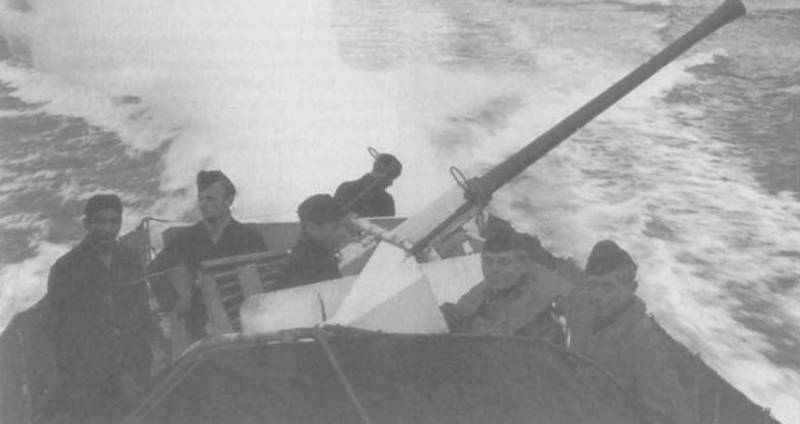
English-language sources claim that during World War II, 4,0 cm Flak 28 anti-aircraft guns were on the cruisers Admiral Hipper and Prinz Eugen. After the Schnellboats began to suffer significant losses from aircraft and collide with British artillery boats, some of the German torpedo boats were armed with 40-mm machine guns.
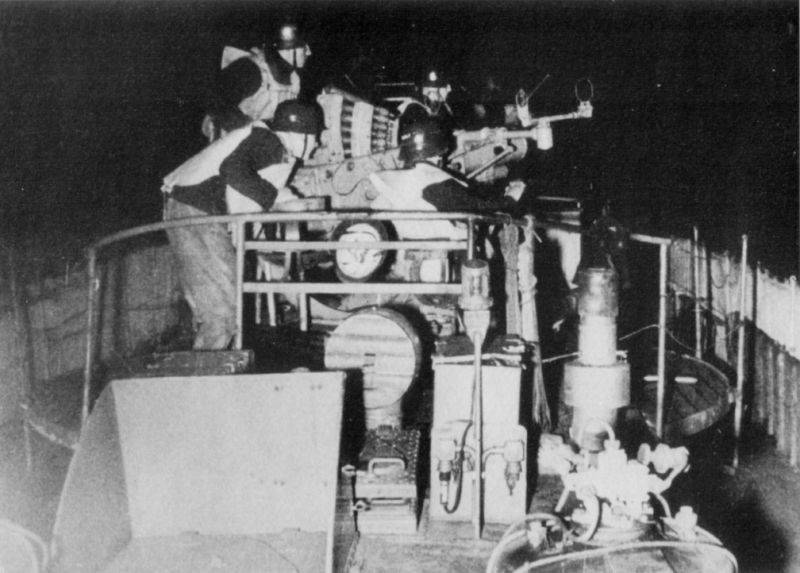
Unlike the 37 mm 3.7 cm Flak M42 guns, the 40 mm anti-aircraft guns were not mounted on pedestals, but on turntables with a wide platform on which the crew was located.
50 mm automatic anti-aircraft gun 5.0 cm Flak 41
Reference publications say that the Kriegsmarine had 50-mm anti-aircraft guns 5.0 cm Flak 41 (Gerät 56) at its disposal. It was not possible to find photographs of such guns on German ships, and, apparently, we are talking about anti-aircraft guns placed on the shore.
The development of the 50 mm gun began in the second half of the 1930s, after the military noticed that there was a gap between 20–37 mm machine guns and 75–88 mm semi-automatic guns at altitudes from 2 to 000 m, at which rapid-fire small-caliber machine guns are no longer so effective, and for heavy anti-aircraft guns with remote fuses, this height is still small. To solve the problem, it seemed justified to create anti-aircraft guns of some intermediate caliber, and the designers of the Rheinmetall Borsig AG concern opted for a 3-mm 500x50B shot. Testing of the prototype 50 mm anti-aircraft gun began in 345, and five years later the gun was put into service.
The installation was transported on a two-axle wagon. In the combat position, both wheels rolled back, and the cruciform base of the carriage was leveled with jacks. The gun turned out to be quite heavy, its mass in combat position was 4 kg. Calculation - 300 people.
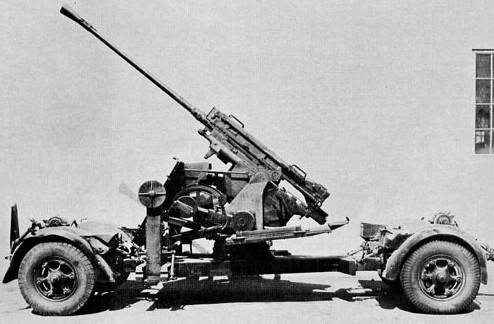
50 mm automatic anti-aircraft gun 5.0 cm Flak 41
The action of the 5.0 cm Flak 41 automation was based on a mixed principle. The barrel bore was unlocked, the sleeve was extracted, the bolt was thrown back and the bolt knurled spring was compressed due to powder gases vented through the side channel in the barrel. And the supply of cartridges was carried out due to the energy of the rolling barrel. The barrel was locked with a wedge sliding bolt. The supply of the machine with cartridges is lateral, along a horizontal feed table using a clip for 5 or 10 cartridges.
Rate of fire - 180 rds / min. The actual combat rate of fire did not exceed 90 rds / min. Elevation angles: from – 10° to + 90°. A fragmentation tracer, weighing 2,25 kg, left the barrel at a speed of 840 m / s and could hit targets flying at an altitude of up to 3 m. The self-destruction of the projectile occurred at a distance of 500 m. with armor penetration at a distance of 6 m along the normal of 800 mm.
Apparently, the number of produced 50-mm anti-aircraft guns does not exceed 200 units. Such an insignificant series by wartime standards is explained by the fact that the 5.0 cm FlaK 41 gun was frankly unsuccessful.
The main complaints were related to ammunition. Even in the daytime, the flashes of shots blinded the crew, and the shells for such a caliber turned out to be low-power. In addition, the shelling of fast moving targets was difficult due to the too low horizontal pickup speed. Nevertheless, 50-mm anti-aircraft guns were used until the surrender of Germany.
55 mm automatic anti-aircraft gun 5.5 cm Gerät 58
Little known is the 55 mm anti-aircraft gun 5.5 cm Gerät 58.
As in the case of the 5.0 cm Flak 41, the reason for the appearance of this artillery system was the desire to increase the effective range of anti-aircraft guns. This model for 55x450V ammunition was developed as a universal weapon suitable both for air defense purposes of ground forces and as anti-aircraft weapons for warships (and for the main armament of light ships and boats).
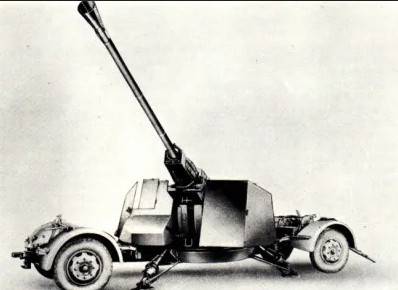
Device 58
The gun created by the Rheinmetall Borsig AG concern is known as the Gerät 58, the specialists of the Friedrich Krupp AG concern designed the Gerät 58K gun.
The 55 mm Gerät 58 automatic anti-aircraft gun with gas automatics had a barrel length of 4 mm (235 calibers). The weight of the gun without the machine was 77 kg. Weight in combat position - about 650 kg. Elevation angles: -3° to +000°. A projectile weighing 10 kg left the barrel with an initial velocity of 90 m/s and was loaded with 2,03 g of explosives. Effective firing range - up to 1 m. Reach in height - 050 m. Rate of fire - up to 450 rds / min. Loading was carried out with a clip for 4 shots.
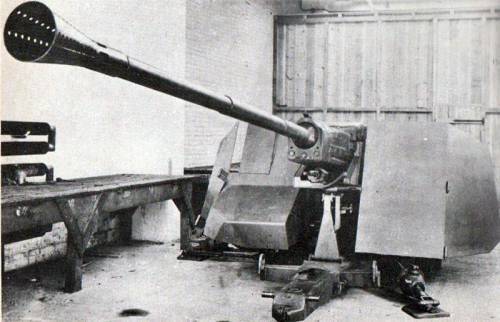
The prototypes of the Rheinmetall Borsig AG concern were tested at the end of 1944. But due to the lack of free production capacity and problems with material resources, it was not possible to launch the 55-mm anti-aircraft gun into mass production.
At the same time, a number of sources claim that the Z-29 type 1936A destroyer, upgraded under the Barbara program, received two experimental 1944-mm 55 cm Gerät 5.5 assault rifles at the end of 58. It was also planned to equip the modernized destroyers of the 55 type with automatic 1944-mm anti-aircraft guns. with diesel engines. This project was created on the basis of an experimental diesel destroyer type 1944, but none of the seven ships laid down was completed.
Information